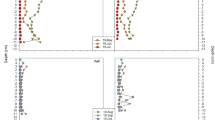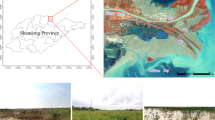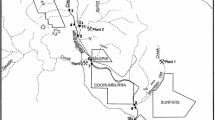Abstract
The concentration and partitioning of metals in vegetatedand unvegetated surface sediments were compared among fourwetlands designed for wastewater treatment. In wetlands witha significant depth gradient, the highest concentrations ofmetals were found in deeper unvegetated sediments. When theeffect of depth was removed, surface sediments with andwithout cattails (Typha latifolia L.) had similarconcentrations of total metals (Fe, Mn, Zn and Cu). However,vegetated sediments of all four wetlands had higher organiccontent (p < 0.01). Furthermore, the redox potential wassignificantly lower (p < 0.01) in vegetated sediments for 3out of 4 wetlands. Vegetated and unvegetated sediments werealso compared based on geochemical fractions (reactive,silicate, persistent organic and pyritic). Generally, halfof the total metal concentration in sediments was associatedwith the reactive fraction (metal oxides, monosulfides andadsorbed onto organic matter). Zn was an exception as halfof the total Zn was associated with the persistent organicfraction. The partitioning of metals in shallow vegetatedsediments differed from deep unvegetated sediments at theMonahan and Falconbridge wetlands. In contrast, there was nosignificant difference in the partitioning of metals insurface sediments with or without cattails at the Panel andRiverwalk wetlands. This study suggests that the effect ofcattails on the bulk concentration and partitioning ofmetals may be minimal in surface-flow constructed wetlands.
Similar content being viewed by others
References
Ansola, G., Fernandez, C. and de Luis, E.: 1995, ‘Removal of organic matter and nutrients from urban wastewater by using an experimental emergent aquatic macrophyte system’, Ecol. Eng. 5, 13-19.
Blais, J. M. and Kalff, J.: 1995, ‘The influence of lake morphometry on sediment focusing’, Limnol. Oceanogr. 40, 582-588.
Bloesch, J.: 1982, ‘Inshore-offshore sedimentation differences resulting from resuspension in the eastern basin of lake Erie’, Can. J. Fish. Aquat. Sci. 39, 748-759.
Breen, P. F. and Chick, A. J.: 1995, ‘Rootzone dynamics in constructed wetlands receiving wastewater: A comparison of vertical and horizontal flow systems’, Wat. Sci. Tech. 32, 281-290.
Brix, H.: 1993, ‘Macrophyte-Mediated Oxygen Transfer in Constructed Wetlands: Transport Mechanisms and Rates’, in G. A. Morishi (ed.), Constructed Wetlands for Water Quality Improvement, Lewis Publishers, Boca Raton, FL, U.S.A., pp. 391-398.
Brix, H.: 1994, ‘Functions of macrophytes in constructed wetlands’, Wat. Sci. Tech. 29, 71-78.
Brix, H. and Lyngby, J. E.: 1983, ‘The distribution of some metallic elements in eelgrass (Zostera marina L.) and sediment in the Limfjord, Denmark’, Estuar. Coast. Shelf. Sci. 16, 455-467.
Caç ador, I., Vale, C. and Catarino, F.: 1996, ‘Accumulation of Zn, Pb, Cu, Cr, and Ni in sediments between roots of the Tagus estuary salt marshes, Portugal’, Estuar. Coast. Shelf Sci. 42, 393-402.
Carpenter, S. R. and Lodge, D. M.: 1986, ‘Effects of submerged macrophytes on ecosystem processes’, Aquat. Bot. 26, 341-370.
Christensen, K. K.: 1997, ‘Differences in iron, manganese, and phosphorus binding in freshwater sediment vegetated with Littorella uniflora and benthic macroalgae’, Water, Air, and Soil Pollut. 99, 265-273.
Coquery, M. and Welbourn, P. M.: 1995, ‘The relationship between metal concentration and organic matter in sediments and metal concentration in the aquatic macrophyte Eriocaulon septangulare)’, Wat. Res. 29, 2094-2102.
Davé, N.: 1993, ‘Panel wetlands: A case history of partially submerged pyritic uranium tailing under water’, MEND Project Report #3.12.2, Energy, Mines and Resources Canada, Canadian Centre for Mineral and Energy Technology, Ottawa, Canada, 222 pp.
Dillon, P. J. and Evans, R. D.: 1982, ‘Whole-lake lead burdens in sediments of lakes in southern Ontario, Canada’, Hydrobiol. 91, 121-130.
Dombeck, G. D. Perry, M. W. and Phinney, J. T.: 1998, ‘Mass balance on water column trace metals in a free-surface-flow-constructed wetland in Sacramento, California’, Ecol. Eng. 10, 313-339.
Doyle, M. O. and Otte, M. L.: 1997, ‘Organism-induced accumulation of iron, zinc and arsenic in wetlands soils’, Environ. Pollut. 96, 1-11.
Dunbabin, J. S., Pokorny, J. and Bowmer, K. H.: 1988, ‘Rhizosphere oxygenation by Typha domingensis pers. in miniature artificial wetland filters used for metal removal from wastewaters’, Aquat. Bot. 29, 303-317.
Ehrlich, H. L.: 1996, ‘How microbes influence mineral growth and dissolution’, Chem. Geol. 132, 5-9.
Froelich, P. N., Klinkhammer, G. P., Bender, M. L., Luedtke, N. A., Heath, G. R., Cullen D. R., Dauphin, P., Hammond, D., Hartman, B. and Maynard, V.: 1979, ‘Early oxidation of organic matter in pelagic sediments of the Eastern equatorial Atlantic: suboxic diagenesis’, Geochim. Cosmochim. Acta 43, 1075-1090.
Gilliam, J. W., Chescheir, G. M., Skaggs, R. W. and Broadhead, R. G.: 1988, ‘Effects of Pumped Agricultural Drainage Water on WetlandWater Quality’, in D. D. Hook, W. D. McKee Jr. and H. K. Smith (eds), The Ecology and Management of Wetlands, Timber Press, Portland, OR, U.S.A., pp. 275-283.
Harlin, M. M., Thorne-Miller, B. and Boothroyd, J. C.: 1982, ‘Seagrass-sediment dynamics of a flooded-tidal delta in Rhodes Island (U.S.A.)’, Aquat. Bot. 14, 127-138.
Havens, K. J.: 1997, ‘The effect of vegetation on soil redox within a seasonally flooded forested system’, Wetlands 17, 237-242.
Huerta-Diaz, M. A. and Morse, J. W.: 1990, ‘A quantitative method for determination of trace metal concentration in sedimentary pyrite’, Mar. Chem. 29, 119-144.
Jackson, L. J., Rasmussen, J. B. and Kalff, J.: 1994, ‘A mass-balance analysis of trace metals in two weed beds’, Water, Air, and Soil Pollut. 75, 107-119.
Kadlec, R. H.: 1995, ‘Overview: Surface flow constructed wetlands’, Wat. Sci. Tech. 32, 1-12.
Kadlec, R. H.: 2000, ‘The inadequacy of first-order treatment wetland models’, Ecol. Eng. 15, 105-119.
Kahkonen, M. A., Pantsar-Kallio, M. and Manninen, P. K. G.: 1997, ‘Analysing heavy metal concentrations in the different parts of Elodea canadensis and surface sediment with PCA in two boreal lakes in southern Finland’, Chemosphere 35, 2645-2656.
Kostka, J. E. and Luther III, G. W.: 1995, ‘Seasonal cycling of Fe in saltmarsh sediments’, Biogeochem. 29, 159-181.
Kvet, J. and Westlake, D. F.: 1998, ‘Primary Production in Wetlands’, in D. F. Westlake and J. Kvet and A. Szczepanski (eds), The Production Ecology of Wetlands, Cambridge University Press, Cambridge, U.K., pp. 78-139.
Otte, M. L., Kearns, C. C. and Doyle, M. O.: 1995, ‘Accumulation of Arsenic and Zinc in the rhizosphere of wetland plants’, Bull. Environ. Contam. Toxicol. 55, 154-161.
Machemer, S. D. and Wildeman, T. R.: 1992, ‘Adsorption compared with sulfide precipitation as metal removal processes from acid mine drainage in a constructed wetland’, J. Contam. Hydrol. 9, 115-131.
Maehlum, T. and Stalnacke, P.: 1999, ‘Removal efficiency of three cold-climate constructed wetlands treating domestic wastewater: Effects of temperature, seasons, loading rates and input concentrations’, Wat. Sci. Tech. 40, 273-281.
Mitsch, W. J. and Wise, K. M.: 1998, ‘Water quality, fate of metals, and predictive model validation of a constructed wetland treating acid mine drainage’, Wat. Res. 32, 1888-1900.
Mitsch, W. J., Wu, X., Nairn, R. W., Weihe, P. E., Wang, N., Deal, R. and Boucher, C. E.: 1998, ‘Creating and restoring wetlands: A whole-ecosystem experiment in self-design’, Bio Science 48, 1019-1030.
Nichols, D. S.: 1983, ‘Capacity of natural wetlands to remove nutrients from wastewater’, Water Pollut. Control Fed. 55, 495-505.
Peverly, J. H.: 1985, ‘Element accumulation and release of macrophytes in a wetland stream’, J. Envir. Qual. 14, 130-143.
Peverly, J. H., Surface, J. M. and Wang, T.: 1995, ‘Growth and trace metal absorption by Phragmites australis in wetlands constructed for landfill leachate treatment’, Ecol. Eng. 5, 21-35.
Reddy, K. R., Kadlec, R. H., Flaig, E. and Gale, P. M.: 1999, ‘Phosphorus retention in streams and wetlands: A review’, Crit. Rev. Environ. Sci. Technol. 29, 83-146.
Reese, R. E. and Moorhead, K. K.: 1996, ‘Spatial characteristics of soil properties along an elevational gradient in a Carolina Bay wetland’, Soil Sci. Soc. Am. J. 60, 1273-1277.
Schoonen, M. A. A. and Barnes, H. L.: 1991, ‘Reactions forming pyrite and marcasite from solution: I. Nucleation of FeS2 below 100 °C’, Geochim. Cosmochim. Acta. 55, 1495-1504.
Sokal, R. R. and Rholf, F. J.: 1993, Biometry, 2nd ed.,W. H. Freeman and Company, New York, NY, 857 pp.
St-Cyr, L., Campbell, P. G. C. and Guertin, K.: 1994, ‘Evaluation of submerged plant beds in the metal budget of a fluvial lake’, Hydrobiol. 291, 141-156.
St-Cyr, L. and Campbell, P. G. C.: 1996, ‘Metals (Fe, Mn, Zn) in the root plaque of submerged aquatic plants collected in situ: Relations with metal concentrations in the adjacent sediments and in the root tissue’, Biogeochem. 33, 45-76.
Stevenson, J. C., Ward, L. G. and Kearney, M. S.: 1988, ‘Sediment transport and trapping in marsh systems: Implications of tidal flux studies’, Mar. Geol. 80, 37-59.
Vymazal, J.: 1995, Algae and Element Cycling in Wetlands, Lewis Publishers, Boca Raton, FL, U.S.A., 689 pp.
Wigand, C., Stevenson, J. C. and Cornwell, J. C.: 1997, ‘Effects of different submersed macrophytes on sediment biogeochemistry’, Aquat. Bot. 56, 233-244.
Author information
Authors and Affiliations
Corresponding author
Rights and permissions
About this article
Cite this article
Goulet, R.R., Pick, F.R. The Effects of Cattails (Typha latifolia L.) on Concentrations and Partitioning of Metals in Surficial Sediments of Surface-Flow Constructed Wetlands. Water, Air, & Soil Pollution 132, 275–291 (2001). https://doi.org/10.1023/A:1013246614159
Issue Date:
DOI: https://doi.org/10.1023/A:1013246614159




